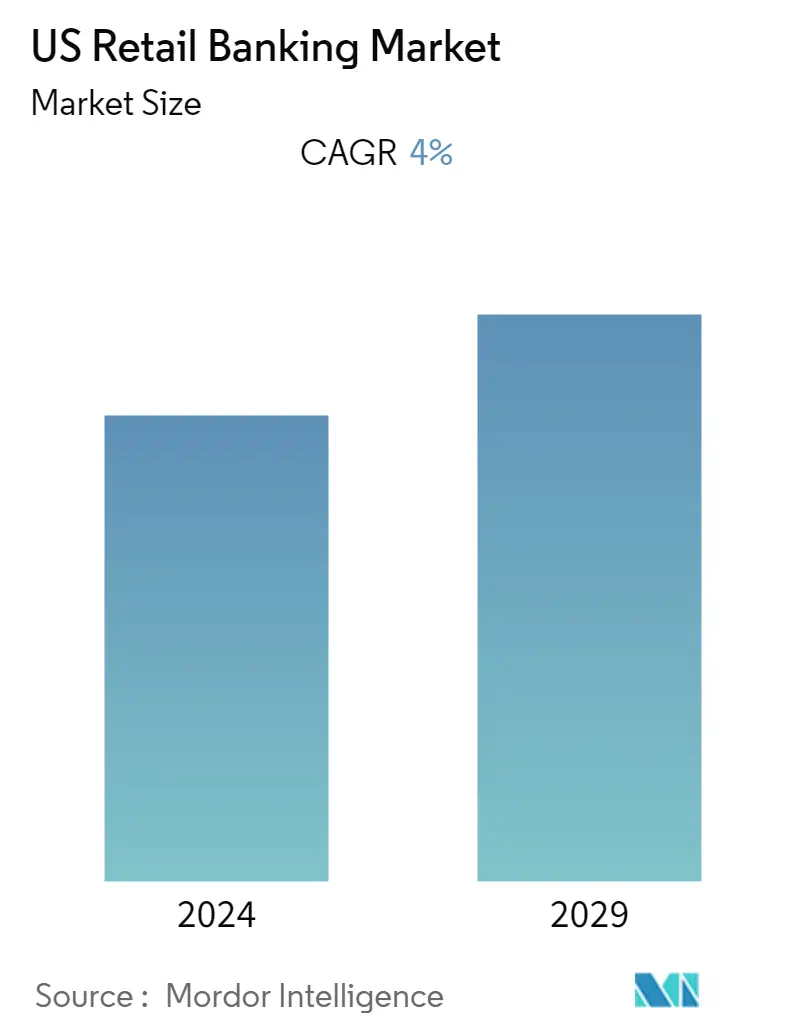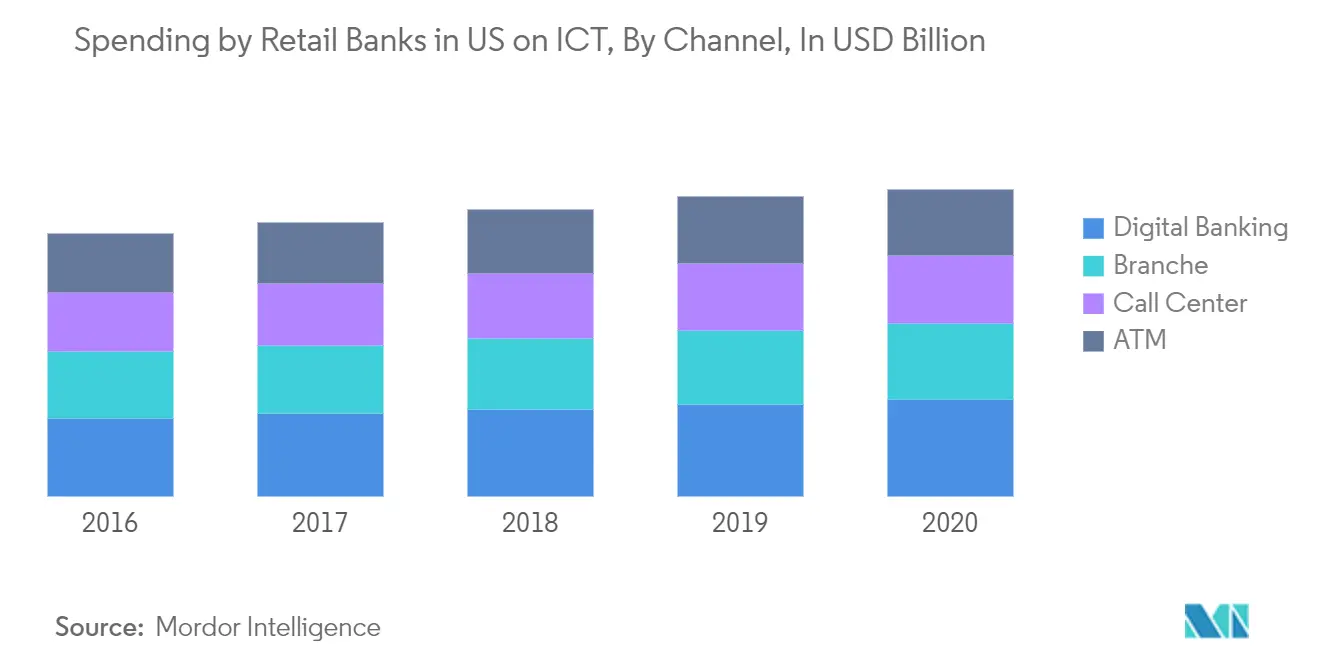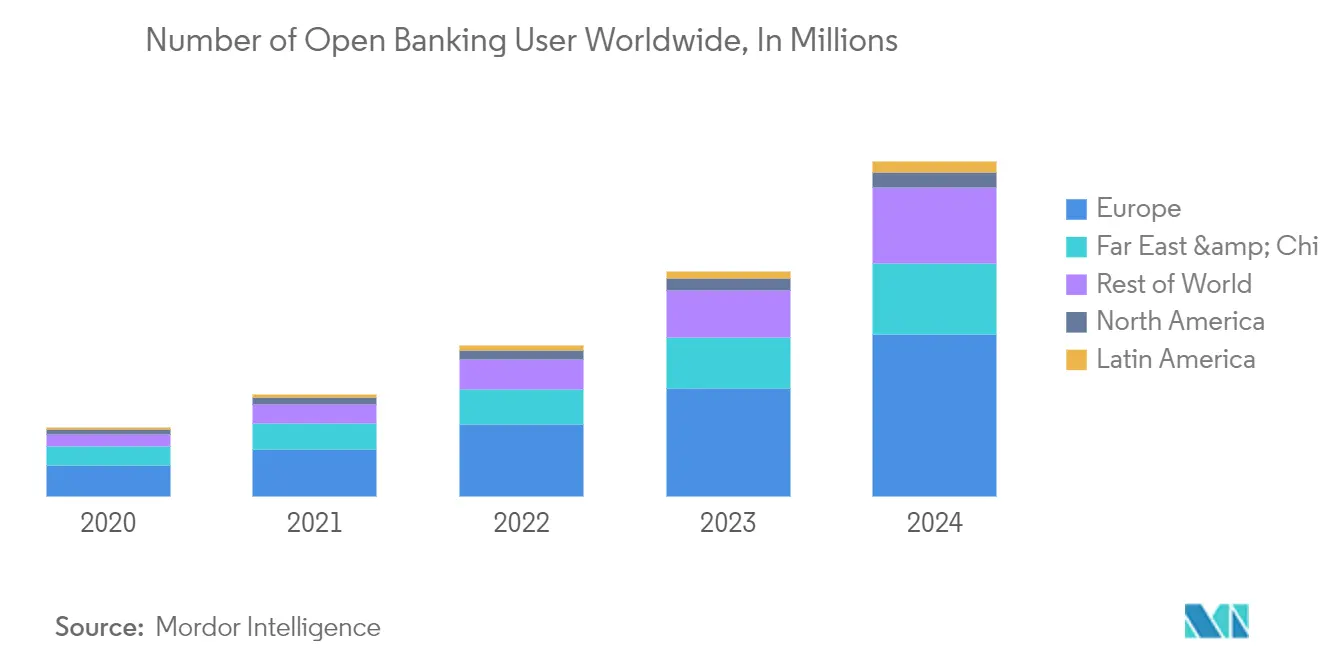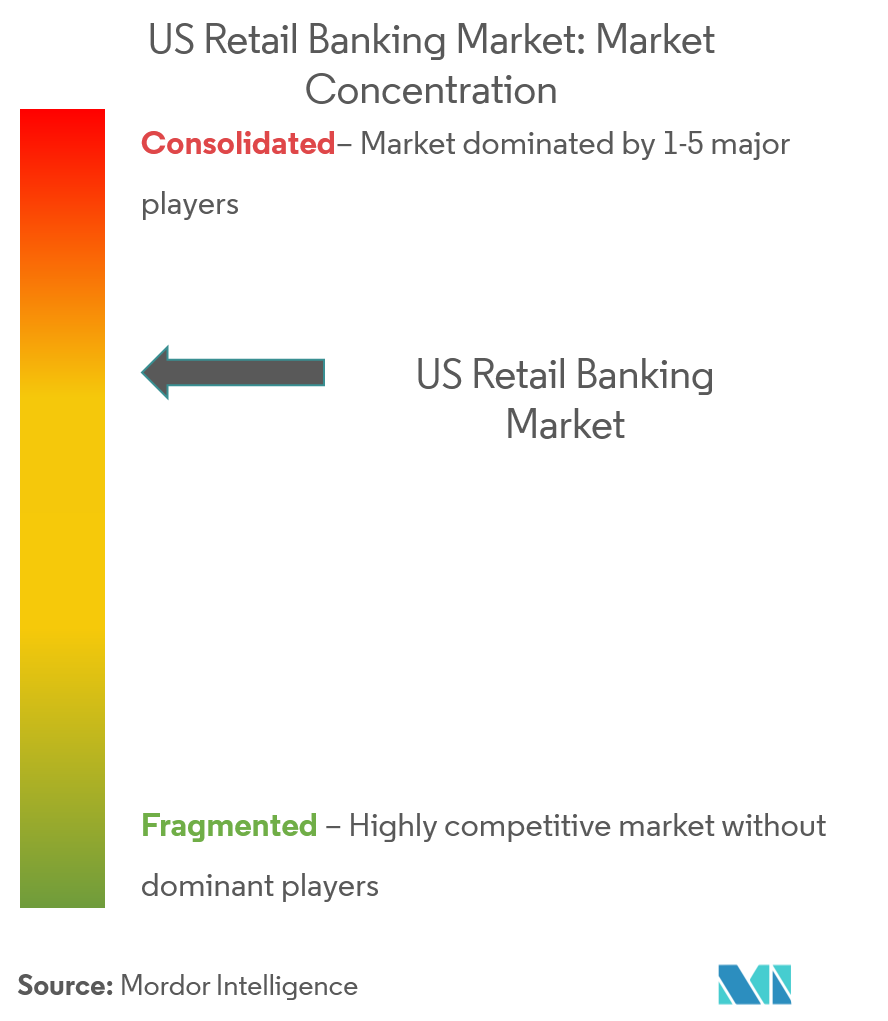US Retail Banking Market Size

| Study Period | 2020 - 2029 |
| Base Year For Estimation | 2023 |
| Forecast Data Period | 2024 - 2029 |
| Historical Data Period | 2020 - 2022 |
| CAGR | 4.00 % |
| Market Concentration | High |
Major Players
*Disclaimer: Major Players sorted in no particular order |
US Retail Banking Market Analysis
The US retail banking market is expected to witness a CAGR of 4.49%, during the forecast period (2021-2026). The high level of household debt in the country is a direct outcome of a rise in domestic consumption, which has proved to be the driving force of the country's economic growth. The credit card balances outstanding was the fastest-growing credit segment. The rising disposable income in the United States contributes positively toward borrowers' enhanced confidence in repaying their loans.
Fee income is falling, driven by decreased retail spending, while non-performing loan ratios will increase - particularly for SMEs. In March 2020, the US government decided to waive all federal student loan interest to address this issue and protect both consumers' and lenders' interests until further notice. Government support, particularly low-cost funding, will help but ultimately can only mitigate the impact. For banks, the severity of losses will depend on whether lockdown restrictions on individuals and businesses can be lifted without a resurgence in cases, or whether businesses will be forced to declare bankruptcy and borrowers will default on their loans.
Most US retail banking brands have a lot to worry about on the digital front, with new tech competitors on the horizon, digital-first banks eating away at their margins, and continuously rising customer expectations. It is no longer good enough to deliver just basics, like online enrollment. Banks must take the next step in digital innovation to compete with fintechs and online banks.
US Retail Banking Market Trends
This section covers the major market trends shaping the US Retail Banking Market according to our research experts:
The Spending by Retail Banks for digital banking is increasing in US.
Fintechs were quicker to recognize that consumer lending niche improve the customer experience with pre-approvals and quicker funding of the loans. Digital lenders more than doubled the market share over the years, with consumers across the credit spectrum increasingly turning to digital-first providers. Investment and collaboration with fintechs are becoming the norm. Major US banks are investing heavily in their FinTech competitors to form strategic partnerships to use their technology and profit down the road if the investments take off. In general, banks can offer their core products but expand into other services using specialized FinTech APIs.
Two-and-a-half billion adults worldwide transact only in cash, according to the World Bank. However, with some digital banks and fintechs offering cheaper and faster services than incumbents, banking is becoming more accessible. For example, companies such as WeChat and Ant Financial have given millions of underbanked Chinese consumers, and small business owners access to secure payments and credit. Financial inclusion can benefit consumers and banks by reducing poverty and expanding the market. But opening banking through digital innovations can also introduce risk. Credit defaults could weigh heavily on fintechs' low margin operations. And financial regulations could introduce data privacy concerns stemming from greater network integration. Careful testing and contextualized consumer strategies are key to managing such risks and ensuring sustainable financial inclusion.
Despite the rise in new payment technologies, many US businesses still use paper checks. However, 55% of business professionals pointed to real-time payments as their top B2B payments priority. Access to these technologies - real-time payments, tap-and-go, and cryptocurrencies will be critical for engaging and retaining commercial customers in the future. Faster payments will enable improved liquidity management, quicker supplier invoice settlements, instant disbursements of insurance claims, and reduced fraud exposure. Improved commercial payment technologies allow banks to enhance customer experiences and grow profit through increased transactions and fees. But as more digital players enter the B2B payments space, incumbents will need to act quickly to avoid being left behind by more nimble competitors.

Open Banking in US is Showing low growth.
In the United States, open banking is expected to evolve as an industry-driven initiative, unlike other countries, where regulatory mandates are forcing many banks to adopt open banking. However, US banks can benefit from lessons learned in these regions, such as establishing technical and customer experience standards for data-sharing/APIs. If done well, open banking can help US banks achieve key strategic goals. Open banking can amplify and accelerate banks' digital transformation efforts and the emergence of new business models.
So far, attitudes toward open banking in the United States appear to be mixed. According to Consumer survey, revealed one in five consumers in the United States find open banking valuable, but the interest is higher among millennials and the Gen Z generation. This suggests US banks should target younger generations in their initial open banking initiatives. But consumers also expressed some concerns, especially about privacy and personal data security and use. This seems to point to a need for banks to educate consumers about the benefits of open banking.

US Retail Banking Industry Overview
The report covers major international players operating in the US retail banking market. In terms of market share, few major players currently dominate the market. However, with technological advancements and product innovation, mid-size to smaller companies are increasing their market presence, by securing new contracts and tapping new markets. Some of the major players in the market are Wells Fargo, JP Morgan Chase and Co, Bank of America, US Bank, PNC Financial Services, BB&T Corporation, Regions Bank, Suntrust Bank, TD Bank and KeyBank.
US Retail Banking Market Leaders
-
PNC Financial Services
-
Bank of America
-
US Bank
-
JP Morgan Chase and Co.
-
Wells Fargo
*Disclaimer: Major Players sorted in no particular order

US Retail Banking Market News
- In May 2021, HSBC announced that it is exiting the retail and small business banking market in the United States, in line with its strategy to refocus on corporate and investment banking in Asia.
- In November 2020, Wells Fargo announced a new solution to help business customers eliminate paper checks by using one-time virtual card numbers to digitally pay invoices through the WellsOne Virtual Card Payments service.
US Retail Banking Market Report - Table of Contents
1. INTRODUCTION
- 1.1 Study Deliverables
- 1.2 Study Assumptions
- 1.3 Scope of the Study
2. RESEARCH METHODOLOGY
3. EXECUTIVE SUMMARY
4. MARKET DYNAMICS
- 4.1 Market Overview
- 4.2 Trends Shaping the US Retail Banking Market
- 4.3 Consumer Behavior and Loyalty Analysis
- 4.4 Government Regulations And Industry Policies
- 4.5 Fintech Disruption in the US Retail Banking Market
- 4.6 Affect of Retail Banking on the US Economy
- 4.7 Recent Developments in the Market
- 4.8 The Future of US Retail Banking Distribution
-
4.9 Market Drivers
- 4.9.1 Next generation technologies
- 4.9.2 Optimized physical distribution: Analytics and workforce fluidity
- 4.9.3 Developing an omnichannel workforce
-
4.10 Market Restraints
- 4.10.1 Big Tech is a growing disintermediation threat
-
4.11 Porters 5 Force Analysis
- 4.11.1 Threat of New Entrants
- 4.11.2 Bargaining Power of Buyers/Consumers
- 4.11.3 Bargaining Power of Suppliers
- 4.11.4 Threat of Substitute Products
- 4.11.5 Intensity of Competitive Rivalry
- 4.12 Impact of Covid 19 on the Market
5. MARKET SEGMENTATION
-
5.1 By Product
- 5.1.1 Transactional Accounts
- 5.1.2 Savings Accounts
- 5.1.3 Debit Cards
- 5.1.4 Credit Cards
- 5.1.5 Loans
- 5.1.6 Other Products
-
5.2 By Channel
- 5.2.1 Direct Sales
- 5.2.2 Distributor
6. COMPETITIVE LANDSCAPE
- 6.1 Vendor Market Share
- 6.2 Mergers & Acquisitions
-
6.3 Company Profiles
- 6.3.1 JPMorgan Chase & Co
- 6.3.2 Bank of America Corp.
- 6.3.3 Wells Fargo & Co.
- 6.3.4 Citigroup Inc.
- 6.3.5 U.S. Bancorp
- 6.3.6 Truist Bank
- 6.3.7 PNC Financial Services Group Inc.
- 6.3.8 TD Group US Holdings LLC
- 6.3.9 Bank of New York Mellon Corp.
- 6.3.10 Capital One Financial Corp.
- *List Not Exhaustive
7. MARKET OPPORTUNITIES AND FUTURE TRENDS
** Subject To AvailablityUS Retail Banking Industry Segmentation
Retail banking, also known as consumer banking or personal banking, is banking that provides financial services to individual consumers rather than businesses. Retail banking is a way for individual consumers to manage their money, have access to credit, and deposit their money in a secure manner. Services offered by retail banks include checking and savings accounts, mortgages, personal loans, credit cards, and certificate of deposit (CDs).The report offers a complete background analysis of the US retail banking market, including an assessment of the parental market, emerging trends by segments and regional markets, significant changes in market dynamics, and market overview.
| By Product | Transactional Accounts |
| Savings Accounts | |
| Debit Cards | |
| Credit Cards | |
| Loans | |
| Other Products | |
| By Channel | Direct Sales |
| Distributor |
US Retail Banking Market Research FAQs
What is the current US Retail Banking Market size?
The US Retail Banking Market is projected to register a CAGR of 4% during the forecast period (2024-2029)
Who are the key players in US Retail Banking Market?
PNC Financial Services, Bank of America, US Bank, JP Morgan Chase and Co. and Wells Fargo are the major companies operating in the US Retail Banking Market.
What years does this US Retail Banking Market cover?
The report covers the US Retail Banking Market historical market size for years: 2020, 2021, 2022 and 2023. The report also forecasts the US Retail Banking Market size for years: 2024, 2025, 2026, 2027, 2028 and 2029.
How is the US Retail Banking Market segmented?
The US Retail Banking Market is segmented by a) Types of Accounts: Savings Accounts, Checking Accounts and Money Market Accounts b) Loan products: Personal Loans, Auto Loans and Mortgages c) Services: Wealth Management, Credit Cards and Online Banking
US Retail Banking Industry Report
The US retail banking market is experiencing significant growth, driven by ongoing digital transformation. This growth is characterized by the adoption of cloud-based solutions and a strong emphasis on cybersecurity, which is essential for enhancing customer trust and safety. The industry is moving towards financial inclusion and collaborating with fintech companies to provide more user-friendly and accessible banking experiences.
Despite challenges posed by rising cybersecurity threats that could affect customer trust and financial stability, growth is evident across various bank types and services. Private sector banks are seeing substantial growth due to their customer-centric approaches and advanced technological implementations. As the landscape evolves with technological advancements, US retail banking companies are focused on offering more personalized and secure services to meet increasing consumer demands.
For detailed statistics on the US retail banking market size, share, and revenue growth, insights into the retail banking industry can be found in the latest industry reports and forecasts. These include historical overviews and future outlooks. Accessing a sample of this detailed retail banking industry analysis is possible through a free report PDF download from Mordor Intelligence™ Industry Reports.
The market size, market share, and industry analysis provide a comprehensive industry overview, essential for understanding market trends. The global market perspective and industry data are crucial for accurate industry forecasts and growth predictions. The industry profile, report PDF, and sales forecast are valuable for sector analysis, while market research and market statistics offer insights into price trends and market dynamics.



